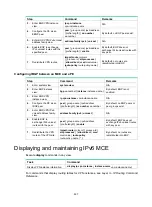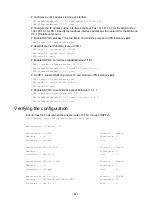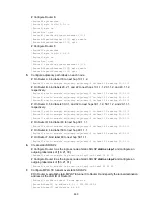
546
•
Determine the incoming label of each transit node's adjacency to a neighbor. On a device, a
static SRLSP, a static LSP, and a static CRLSP cannot use the same incoming label.
•
Enable MPLS on interfaces that will participate in MPLS forwarding. For information about
enabling MPLS, see "Configuring basic MPLS."
Configuring an adjacency path
Perform this task on all nodes that a static SRLSP might traverse.
Multiple static SRLSPs can share an adjacency path.
To configure an adjacency path:
Step Command
Remarks
1.
Enter system view.
system-view
N/A
2.
Configure an adjacency
path.
static-sr-mpls adjacency
adjacency-path-name
in-label
label-value
{
nexthop
ip-address
|
outgoing-interface
interface-type
interface-number
}
By default, no adjacency paths
exist.
Do not specify a local public IP
address as the next hop address
when configuring an adjacency
path.
Configuring a static SRLSP
Perform this task only on the ingress node of a static SRLSP.
To use a static SRLSP to forward MPLS TE traffic, you must first perform the following operations:
1.
Create an MPLS TE tunnel interface on the ingress node.
2.
Bind the static SRLSP to the tunnel interface.
For information about configuring MPLS TE, see "Configuring MPLS TE."
To configure a static SRLSP:
Step Command
Remarks
1.
Enter system view.
system-view
N/A
2.
Configure a static SRLSP.
static-sr-mpls lsp
lsp-name
out-label
out-label-value
&<1-13>
By default, no static SRLSPs
exist.
Binding a static SRLSP to an MPLS TE tunnel
interface
Perform this task only on the ingress node of a static SRLSP.
To bind a static SRLSP to an MPLS TE tunnel interface:
Step Command
Remarks
1.
Enter system view.
system-view
N/A
2.
Enter MPLS TE tunnel
interface view.
interface tunnel
tunnel-number
[
mode
mpls-te
]
N/A






























